As part of our ongoing efforts to chart the rise and rise of IPv6, we’ve been looking into the difference between average IPv6 capability per country over a few days in June 2020 versus the most recent similar averages for 2021.
2021 marks a full ten years since World IPv6 Day, the coordinated test event that led to the IPv6 launch event on 6 June 2012. We’re all aware that IPv6 deployment is, so far, a mixed story: depending on your network, it might either be the dominant network protocol, or it might be an item kicked into the long-grass of a planning document years into the future, or (more likely) it’s somewhere in the middle of that spectrum.
So as usual, let’s ask ourselves: where are we now, globally, and what’s changed?
What’s Changed?
Last question first. What’s changed in the last year?
The pandemic has of course changed a great many things, including network traffic patterns, such as a shift away from corporate network traffic towards more domestic traffic during weekdays. Let’s take a look at the data generously made available by APNIC.
Since we’re interested in what’s changed, we’ve opted to create a map of deltas per country, to show us clearly the differences in percentage of IPv6 readiness by country:
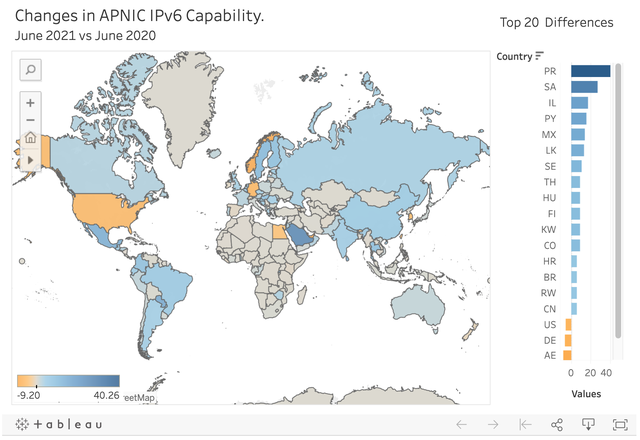
Click here for an interactive version of this visualisation
We’re showing the difference between an average (mean) measure of IPv6 capability per country over a few days in June 2020 versus the most recent similar averages for 2021. Greys are neutral; blues indicate a positive change (a higher proportion of IPv6 readiness); and oranges indicate a negative change (a lower proportion of IPv6 readiness).
There are a couple of notable upticks in this data that stand out.
First, Puerto Rico appears to be a clear winner by the APNIC measurements, though this must be viewed through the filter of a relatively small population and how capable geo-datapacks are at identifying users as being located in Puerto Rico or the US. The major US networks operate here, and so cellular deployments include the same IPv6-ready mobile carriers. Granularity of the data and classification of PR vs. US affects measurements heavily, leading to wildly different measures for Puerto Rico - Google says 6.48% IPv6 traffic today, while Facebook measures 2.79%. We’ve written about differing IPv6 metrics in the past.
This is followed by Saudi Arabia, with a significant population over 34M, where various IPv6 measurement metrics agree that IPv6 readiness has risen over 40% in recent months. Also at the top of this list is Israel, which had some IPv6 traffic before June 2020, but has shown a clear uptick to around 25% readiness in the last year. Paraguay, which had effectively no IPv6 until the tail end of 2019, showed a clear uptick at the end of 2020 to now approach 20% readiness. And then Mexico has been on a steady increase over the last few years and is now at around 40% readiness. The figures for each of these countries indicate significant IPv6 deployment efforts.
There are a couple of surprises in the other direction, however. The USA is the most surprising, and the picture is probably slightly complex. The USA has had a strong IPv6 deployment program since serious deployments began, and it’s fair to say there are fewer big turn-up events that are still waiting to happen as we might see in some other countries. Meanwhile, one year ago, stay-at-home orders were being adhered to, and here in mid-2021 the US is some months into their rapid vaccination program. We know well enough that corporate networks tend to lag their domestic and mobile ISP counterparts with regards to their IPv6 deployment, so this shift might indicate a shift back to people spending time in offices rather than working from home. Similar may be true in, for example, Germany, if restrictions are easing and working from home is becoming less common. We see little evidence of many networks significantly reducing their IPv6 footprints, which suggests that IPv6 availability isn’t going away - the traffic is simply moving around again.
Standing Starts and Other Notable Jumps
There are of course countries with absolutely no IPv6 deployment, at least beyond extremely small networks and test deployments. That’s a nontrivial list of countries, but it’s a list that gets a little smaller each year.
We can see one of those above: Pakistan appears to have moved from near-zero IPv6 readiness in mid-2020 up to 2.3% in mid 2021. With a population of over 225M, this is a nontrivial traffic shift. And it’s not just Pakistan. There are movements in other places:
| Country | IPv6 Readiness, 2021 | Internet Users (approx, from wiki*) |
|---|---|---|
| Guam | 7.4% | 0.13M |
| Rwanda | 6.3% | 2.6M |
| Croatia | 3.1% | 2.8M |
| Saint Lucia | 3.0% | 0.09M |
| Seychelles | 2.9% | 0.06M |
Of course, not all countries have populations in the many millions, but local network operators are getting to work in these places to deploy IPv6, and that’s great news. Significant deployments in Rwanda and Croatia help move the global IPv6 traffic even more. Other notable jumps that were already over 0% a year ago include Kuwait, moving from 2% IPv6 to 11%, and Thailand, shifting from 33% ready to 40% readiness.
Where are We Now?
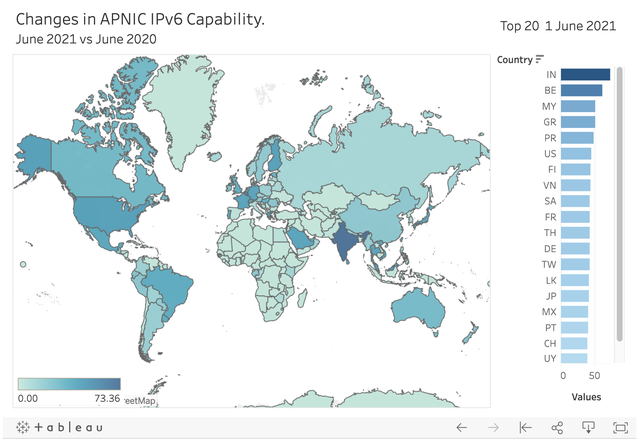
On the interactive map, you can jump between 2020 or 2021, to compare how each year looks. Given that the size of the population that has Internet access will, in part, drive the volume of traffic in any given country or region, the changes across large countries sorted by Internet population looks as follows:
| Country | IPv6 readiness, 2021 | Readiness delta from 2020 | Internet Users (approx, from wiki) |
|---|---|---|---|
| China | 21.3% | +5.4% | 989M |
| India | 73.4% | +4.6% | 756M |
| USA | 45.5% | -6.1% | 312M |
| Indonesia | <1% | 212M | |
| Brazil | 38.2% | +6.0% | 160M |
| Nigeria | <1% | 136M | |
| Russia | 10.4% | +3.4% | 119M |
| Bangladesh | <1% | 117M | |
| Japan | 41.6% | +1% | 116M |
| Pakistan | 2.3% | +2.3% | 101M |
Each of these countries has significant Internet populations, where small deltas can make a real impact on how much traffic is served over IPv6 vs. IPv4. The general trend in the last year indicates a greater level of IPv6 readiness, though of course this may be mediated by home working and a future partial shift back towards office work (as suggested already for the US).
Conclusions
IPv6 clearly isn’t “done” yet - there’s a lot of work still to do if the protocol is to eventually become ubiquitous. And the same story of previous years is perhaps still true: more ASNs are announcing IPv6 than before, and so piece by piece we approach some sort of parity. The deployment is still uneven, though. Many countries do not have any apparent IPv6 traffic at all, and although the large content providers have been IPv6-ready for many years (being the primary participants in the IPv6 launch events), access networks are a mixed bag and corporate networks still seem to be trailing.
Regardless, there is clear progress, and we can see that in multiple regions around the world, in both large countries and small. This is good news!
If you’re interested in learning more about IPv6, we of course have various RIPE Labs articles and other resources available.
Our many thanks to various inputs on the state of IPv6 deployment in UAE, Puerto Rico, and the US!

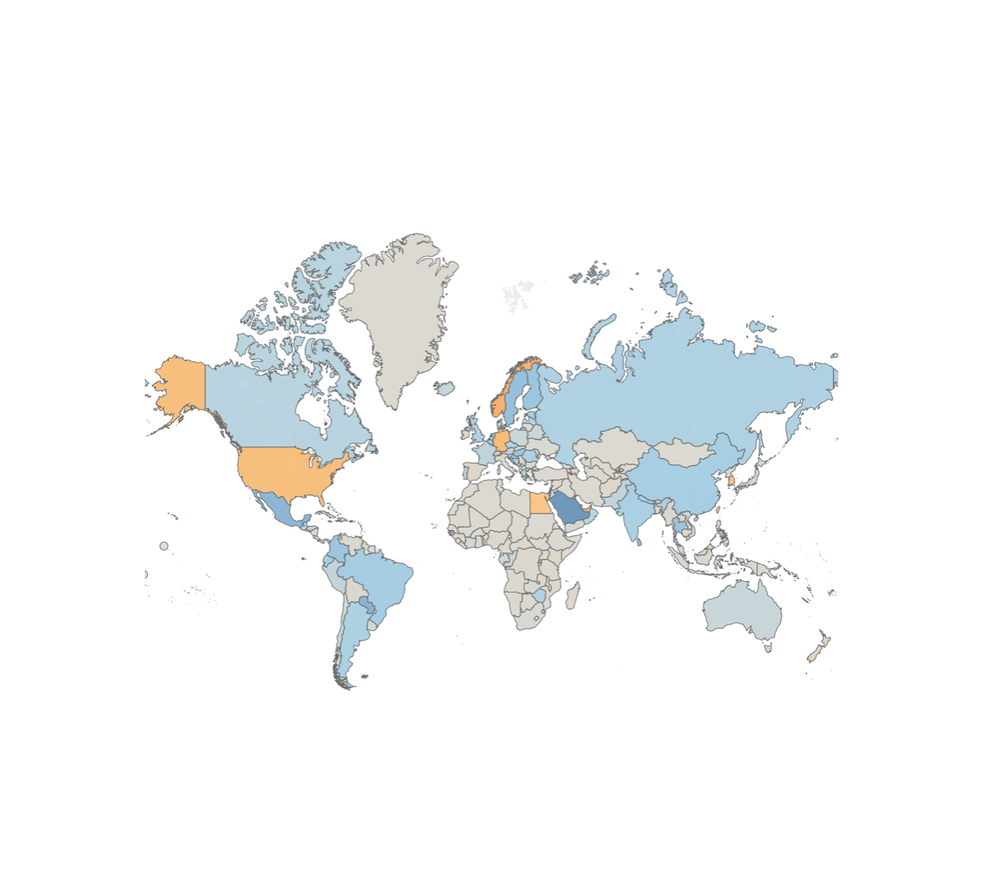
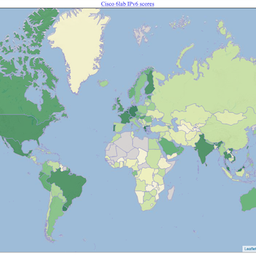


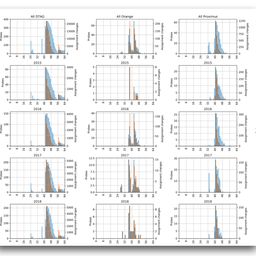
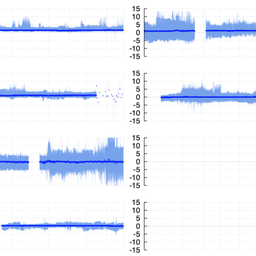
Comments 0
The comments section is closed for articles published more than a year ago. If you'd like to inform us of any issues, please contact us.